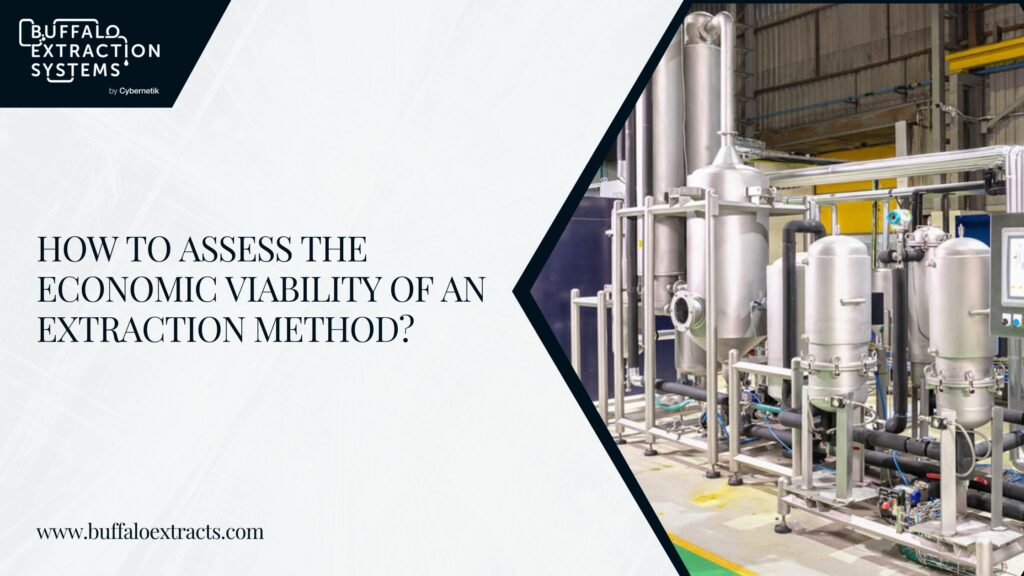Assessing the Economic Viability of Extraction Methods
Industries continue to seek efficient and sustainable methods for extracting valuable compounds from natural sources.It is in this context that techniques such as supercritical fluid extraction (SCFE) and cryogenic extraction have gained prominence. These methods offer advantages such as reduced environmental impact, higher purity of extracted compounds, and lower solvent consumption compared to traditional spice extraction methods.
To assess the economic viability of extraction methods, a comprehensive assessment of various factors is required. These factors include capital investment, operational costs, yield, and market demand. Such an assessment helps in making informed decisions about the feasibility of adoption of such techniques.
In the present article, we aim to explore the economic feasibility of extraction methods. The methods we will examine include supercritical fluid extraction (SCFE) and cryogenic ethanol extraction. To achieve this, we will highlight key considerations and methodologies for these. Following are some of the key considerations and methodologies that are used to assess the economic viability of extraction methods:
- Scalability:A scalable extraction method can be easily expanded or contracted without incurring exorbitant additional costs. Neither does it disrupt operations to a significant extent. When assessing scalability, consider factors such as the flexibility of the equipment, ease of integration with existing infrastructure, and potential bottlenecks that may limit scalability.
- Regulatory Compliance:Extraction methods must comply with various regulations related to safety, environmental protection, quality control, and product labeling. Assess the regulatory landscape to ensure that the chosen extraction method meets all applicable requirements and consider the costs associated with compliance, such as obtaining permits, conducting inspections, and implementing safety protocols. The best course of action is to consult an experienced specialist who can guide you through the regulation maze not only regarding your current equipment, but also be able to guess the same for the situation when you scale up.
- Environmental Impact:Evaluate factors such as energy consumption, water usage, waste generation, and emissions of pollutants or greenhouse gases which can impact various ecosystems, natural resources, and the atmosphere. Choose spice extraction methods that minimize environmental harm through energy-efficient processes, waste reduction measures, and the use of sustainable materials or renewable resources.
- Risk Assessment:Includes both internal risks, such as equipment failures or supply chain disruptions, and external risks, such as changes in market conditions or regulatory requirements. Conduct a thorough risk assessment to identify potential threats to the economic viability of the extraction method, and develop mitigation strategies to minimize their impact on operations and profitability. Here again, regulation experts can be useful, aware as they will be of potential changes in regulations. Market changes often trigger of regulatory amendments. Being in touch with consultants, therefore, helps.
- Total Cost of Ownership (TCO):The total cost of ownership (TCO) encompasses all costs associated with owning and operating Cannabis extraction equipment over its entire lifecycle. This includes acquisition costs, such as purchasing or leasing equipment, as well as ongoing expenses such as energy consumption, maintenance, repairs, and disposal costs. Calculate the TCO to determine the total financial investment required for the extraction method and compare it with the expected benefits and returns over time.
- Technological Advancements:Stay informed about technological advancements and innovations in extraction technology that could improve efficiency, reduce costs, or enhance product quality. Evaluate the potential impact of adopting new technologies or process improvements on the economic viability of existing extraction methods. Consider factors such as the feasibility of implementing new technologies, compatibility with existing infrastructure, and potential returns on investment in terms of cost savings or revenue generation.
- Value-Added Products:Explore opportunities to create value-added products using the extracted compounds, such as pharmaceuticals, nutraceuticals, cosmetics, or flavorings. Identify niche markets or applications where premium-priced products can command higher margins and generate additional revenue streams. Develop strategies to capitalize on these opportunities and differentiate your products from competitors in the market.
- Long-Term Sustainability:Consider the long-term sustainability of the extraction method in terms of its ability to maintain efficiency, profitability, and relevance over time. Evaluate factors such as resource availability, process scalability, market demand, and potential environmental impacts to ensure that the chosen extraction method remains viable and sustainable in the long run. Aim for solutions such as the application of supercritical fluid extraction that align with sustainability goals and contribute to the resilience and longevity of your business operations.
- Return on Investment (ROI):Calculate the expected return on investment (ROI) based on projected revenues and costs over a specified time horizon. Consider financial metrics such as payback period, internal rate of return (IRR), and net present value (NPV) to assess the profitability and attractiveness of the extraction method from an investment perspective. Compare the expected ROI of different extraction methods to identify the most promising opportunities for maximizing returns and achieving financial objectives.
Conclusion,
To assess the economic viability of extraction methods, it is necessary to evaluate capital investment, operational costs, yield, product quality, and market dynamics. Supercritical fluid extraction and cryogenic extraction are examples of such methods. These methods require systematic evaluation to determine their feasibility. Advanced extraction techniques offer several advantages, such as improved efficiency and product quality. However, companies must carefully consider the associated costs and potential returns on investment.
Conducting thorough feasibility studies, market analyses, and revenue projections can help decision-makers make informed choices regarding the adoption of SCFE or cryogenic extraction technology. To determine the most economically viable approach to extract valuable compounds from natural sources, companies have to weigh the costs and benefits. They should also consider market opportunities to make an informed decision. By doing so, companies can ensure maximum profitability and sustainability.

